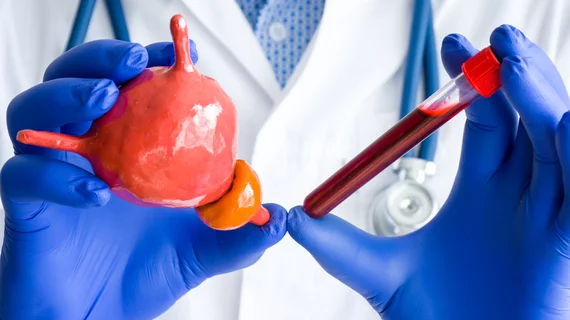On its own, MRI-targeted biopsy takes big bite out of prostate cancer overdiagnosis
By biopsying only patients who had suspicious lesions on prostate MRI on top of elevated PSA levels, researchers trialing an MRI-only approach halved the risk of overdiagnosis.
And the gain came by delaying the discovery of a tiny percentage of clinically significant cancers.
The work was conducted in Sweden and is described in a paper published Dec. 8 in the New England Journal of Medicine [1].
Jonas Hugosson, MD, PhD, of the University of Gothenburg, and colleagues recruited around 18,000 men aged 50 to 60 with elevated PSA levels to undergo screening for prostate cancer.
Six thousand or so of these were randomly placed in a reference group, receiving either systematic biopsy or targeted biopsy following suspicious MRI findings.
The rest made up the experimental group, receiving MRI-targeted biopsy only.
Analyzing the results, Hugosson and co-authors found 66 of 12,000 participants in the experimental group (0.6%) ended up with a diagnosis of clinically insignificant prostate cancer.
This compared with 72 of 6,000 participants (1.2%) in the reference group—a difference of −0.7 percentage points.
Small Prostate Cancers: ‘A Major Contributor to Potentially Harmful Overdiagnosis’
The team further found the relative risk of clinically significant prostate cancer in the experimental group as compared with the reference group was 0.81.
Clinically significant cancer detected only by systematic biopsy was diagnosed in just 10 participants in the reference group—and “all cases were of intermediate risk and involved mainly low-volume disease that was managed with active surveillance,” the authors report.
Serious adverse events were vanishingly rare—less than 0.1% across the two groups.
“Our trial showed that changing the diagnostic algorithm to include prebiopsy MRI in all participants with elevated PSA levels and only targeted biopsy of lesions with a PI-RADS score of 3 to 5—and no biopsy of lesions with PI-RADS scores of 1 to 2—reduced the risk of detecting Gleason 3+3 cancers by half,” Hugosson and co-authors underscore in their discussion. “Since the frequent detection of small Gleason 3+3 cancers after PSA screening is regarded as a major contributor to the high incidence of potentially harmful overdiagnosis of prostate cancer, this finding is of importance.”
More:
This strategy also considerably reduced the percentage of biopsies in participants in the experimental group who had elevated PSA levels. Although the incidence of severe adverse events after prostate biopsy in our trial was low—probably owing to the relatively young age of the participants—prostate biopsy is an unpleasant and potentially risky procedure.”
Study’s Import ‘Needs to Be Weighed by the Clinical Community’
In invited commentary on the study, Roman Gulati of the Fred Hutchinson Cancer Center in Seattle calls out Hugosson and co-authors’ “bottom line” finding: Omitting systematic biopsy halved the probability of detection of clinically insignificant cancers—but one in five clinically significant cancers was missed [2].
“Of note, all the clinically significant cancers that were found only by means of systematic biopsy were of intermediate risk (Gleason score, 3+4), and most were low volume,” Gulati emphasizes. “Whether the trade-offs of omitting systematic biopsy are acceptable needs to be weighed by the clinical community in the context of contemporary standards of care.”

